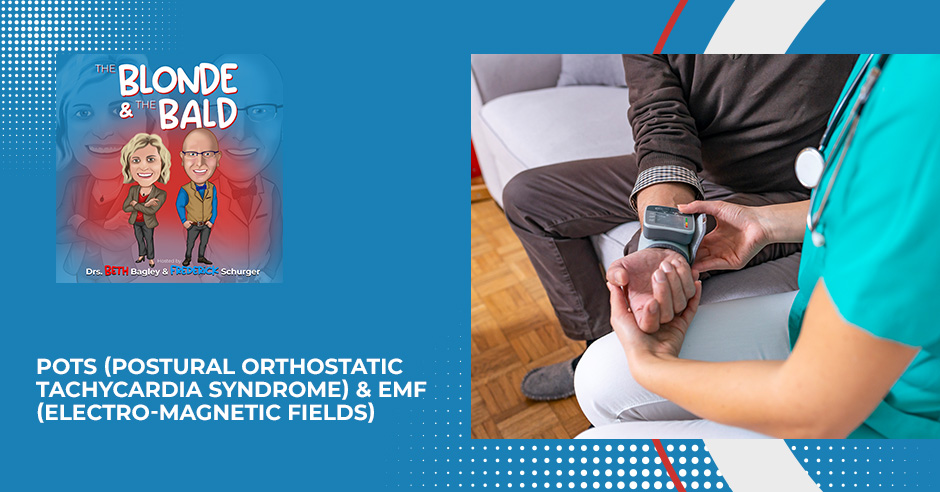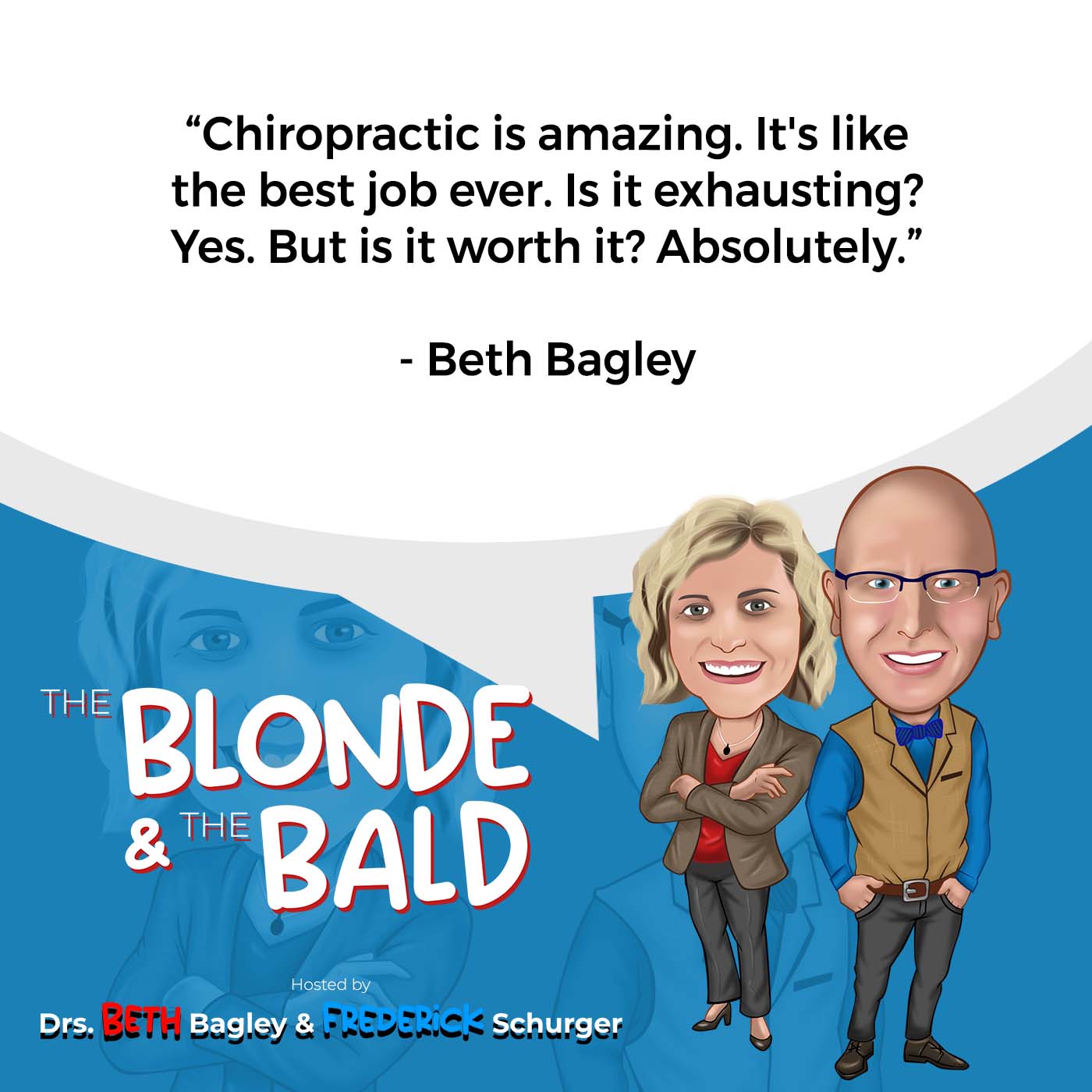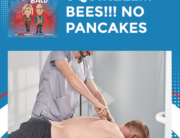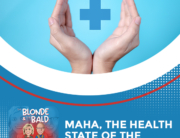
Dr. Frederick Schurger discovered a horrible deep drinking game: every time he uses an acronym, take a shot. Don’t play this drinking game.
In this eye-opening episode, Dr. Beth Bagley and Dr. Frederick Schurger dive deep into the mysterious world of health issues that are often hidden in plain sight. Join them as they explore two main subjects: Postural Orthostatic Tachycardia Syndrome (POTS) and the invisible web of Electro-magnetic Fields (EMF). POTS is a condition that affects countless individuals, causing symptoms like rapid heart rate, dizziness, and fatigue. Our hosts share stories of patients with POTS, its impact on their lives, and how they have been helping them improve their function, often from disability to being able to walk in the park (Yes, moving a little 2-ounce bone at the neck is involved!) Dr. Bagley and Dr. Schurger also shed light on the often-overlooked role of EMFs—from cell phones, Wi-Fi, and more—in influencing your health in ways you never imagined. Don’t let the unseen threats of our digital age compromise your vitality. Tune in now to take the first step toward a healthier, more EMF-aware life.
—
Watch the episode here
Listen to the podcast here
POTS (Postural Orthostatic Tachycardia Syndrome) & EMF (Electro-magnetic Fields)
We Almost Called This The POTS & Pans Episode…
How was your week?
It was great. My wife and I ran down to see Dr. Harshfield in Little Rock. We even stopped to get an upright MRI for her. I have an upright MRI thing for people who are interested in asking questions and they say, “I want to go get an upright MRI.” For whatever reason, have you had any patients that said, “I’m going to go get this upright MRI,” and then they came back? They don’t order it through you or ask how to do it right. They then come back with an upright MRI into your office.
Yes.
The results didn’t look as good.
It was weird because they did two different MRIs on a section and I just needed one. That was not what I wanted.
Here’s the other thing that’s not what you wanted. When I told this to the radiologists who taught me a lot about upright MRIs, he was like, “What do you mean they did it that way?” When you take a regular MRI, you’re lying on your back. That’s how that ends up working. That changes the structures within your body. If you’re walking around in gravity like most of us are, you have a different presentation of the stuff inside as well.
Everything is not suspended as cleanly as we would like, especially after a trauma. What they’re supposed to do with an upright MRI is, “Have you at 90 degrees so that you are upright in gravity like you are walking around everywhere else?” What they have been doing because of motion issues is they have been taking the MRIs at 45 degrees. You are just as upset about this and dumbfounded about why you even bother with the upright machine.
We might as well take it.
You are not getting enough of gravity impacting on the patient the way that it is impacting on their daily life.
I have a question for one of my patients. I will ask her that next time I see her.
I had a patient who went down there. This is the one in Saint Louis, although I wouldn’t be surprised if we have the same issues at other locations. Chicago is the other one that I see a lot of people go to but he went down there and is like, “That’s how they always take them at a 45-degree angle.” I’m like, “That’s odd.” We go in for my wife’s and we’re setting her up. She said, “We’re going to take you back to 45 degrees.” I’m like, “No.” I’m glad I was there and I wouldn’t have been there for hers. She even realized, “That’s not what we need.”
“We need to see what it’s like when I’m up.”
We have that situation. If you’re getting it and they say, “No, we’re going to take it at 45 degrees,” they have other ways to immobilize you. What ends up happening is you end up having some motion as you’re in this upright MRI because they don’t have the materials to strap you in properly. They’ve got you strapped into a degree but they do have a bar that they can put across your forehead to help you. It’s something that you can lean against.
I would rather a patient have something to lean their head up against and have a non-perfect posture than that bar in their lap. The bar on their lap does no good. The bar here that allows them to lean and hold is going to do far more good for them when they’re getting these pictures taken. We did this not only for the regular series but also for the CCJ or Craniocervical Junction series. We can make that a drinking game. Every time I say an acronym, “Don’t drink. Alcohol is poison.”
You can drink water.
You should drink water. If you’re going to do the flexion-extension ones, also have that bar be the thing you’re going to lean into. I need to rewrite the entire protocol.
I would love that and I bet some of the doctors reading might want that too.
It’s a double part to it. It’s not just a protocol of how the scans are taken but how the patient needs to be positioned. These are little things because the young lady who’s running that machine is fantastic. She was very helpful. She’s part-time there. She is not always the one working that machine and they’re open. A lot of these places are open for long hours.
There can be multiple people working.
If they don’t understand the protocols that we’re doing, we’re not going to get good pictures. We got great pictures. My wife’s a mess but hopefully, there are some things we can do and improve. I’m going to have to write a full report for her. That’s something interesting.
I’ll remark on why, as upper cervicals, we want an upright MRI. We’ve talked about this on other episodes but in case you’ve picked those up. If a patient is lying down in an MRI, especially cerebellar tonsils and the brain falls into the cradle of the skull. It comes clunking down there. What it will do is if there is some prolapse of the brain tissue that is going into where it’s not supposed to be going into the neck, it might not but it might go away so then you won’t see it.
In operating MRI, if you’re at 90 degrees, we should see on a person who has something like a Chiari or low-lying tonsils, some protrusion of part of the brain tissue, that Atlas-based skull frame, and magnum, the hole at the bottom of your skull. It will be coming through, which we don’t want to be but if it is, we want to be able to see it.
That leads me to a win that we had in the office. We had a patient come in a wheelchair not because she couldn’t walk but because she has this disease or a syndrome called POTS or Postural Orthostatic Tachycardia Syndrome. When she moves in certain directions, sits up from lying down, or stands up, she immediately passes out and faints. It was happening to her multiple times a day. It’s terribly affected her life.
Honestly, she came into the office for something else. We didn’t want to promise her that this was going to get better. We don’t fix POTS or anything. We fixed the subluxation of the spine. When she started coming in, we were excited. Future Dr. Lad took her initial intake and everything. I made the initial few adjustments. Dr. Lad has made a few adjustments. This young lady was at the park and was able to take ten steps before she had to sit down in a wheelchair and still didn’t pass out. That was a big win.
She was so excited to tell us that she was walking on a beautiful day and was able to get up and move. She’s also been getting out of the house more because she feels comfortable doing it. That is amazing. That’s one of the people that I’d want to see an upright MRI on because it can be a relationship between what’s happening in there. Have you had any patients with POTS in the past?
My wife has POTS. I’ve had a couple. We were talking about it with Dr. Harshfield when I was down there visiting with him. He was saying that it’s pretty common anytime you start having pressure in the way that things are moved. You have pressure on the vagus nerve that prevents normal hypertension-style changes. We’re not talking about hypertension but we’re talking about the body’s normal ability to raise and lower the blood pressure as you change positions.
I’m looking over some stuff here on POTS. They’re saying that it’s an increase of heart rate above 120 beats a minute in the first minutes of standing in the absence of any other hypotension or Earth ecstatic intolerance, which is fancy words. There’s nothing else happening. You’ve got this vagal tone, a problem with the vagus nerve, not working the way it’s supposed to.
That can lead to a bunch of different problems. If we get Jeanne clear, she’s got great days. I’ve seen days when if we get her clear enough, it’s like she’s a new woman as long as I don’t say something crap. I find crap things to say all the time. I’ve had several who do better. The question becomes, “How much can you promise and how much better will they be consistent?”
That’s why we don’t promise anything. This is not a cure for POTS but it’s very awesome. She was so excited that she saw any change because she hadn’t for years. She’s on disability. She is a young person who can’t have a job and she can’t do all these things. She was able to go to the Barbie movie. She was excited to say that she was able to get out and go to a movie. It’s incredible.
It is amazing what the body can do to varying degrees as far as how people can heal and how fast they can heal. I had a patient come in. She missed her appointment. First off, it’s her husband’s fault because somehow she didn’t get the message on her phone that he was supposed to bring her in. I don’t know what happened there. It’s like, “She was supposed to come in.” It’s like, “I can’t get her in. She didn’t want to come in this morning.” “She needs to come on Thursday.”
It is amazing what the body can do and to varying degrees as far as how people can heal and how fast they can heal.
The ex-husband was drinking too much that night and decided to go into an embankment and under a bridge. She went through the windshield and hit her head many years ago. She’s doing much better. She can get around. She’s like, “I don’t feel bad,” when she’s in alignment. She didn’t come in because Thursdays are bad for her. When she came in, she was like, “Thursdays are so bad. This is miserable. I don’t want to rest too long.”
Just getting on the table hurt her to lie down. I get her adjusted. I have her go right to the resting room because I’m confident that she needs some time to rest after her head is back on straight. I could see it in the graph. It was one of those things. When is walking, she’s like, “I think I’m walking better and feeling better. Could it happen that fast?” “It can.”
I had another young lady who was 20 years younger than her come in 1 hour or 2 later. She said the same thing, “I should have been here last week.” I was like, “Sometimes you should have been.” This is the amazing thing about how we can address people in such a simple little thing like moving a 2-ounce bone underneath your skull so you can have profound effects on your overall health and well-being in ways that we don’t even understand.
This is the amazing thing about how we can address people’s conditions. It’s such a simple little thing, like moving a two-ounce bone underneath your skull, and you can have profound effects on your overall health and well-being in ways that we just don’t even understand.
From your head to your toes, everything’s connected. Do you have an article on POTS that you want to bring up?
There are a couple of things. This was a chiropractic case. Relief of Orthostatic, Hypertension, and Tachycardia with Chiropractic Rehab. As we were discussing your POTS case, we were going over some bits and pieces. This was a 50-year-old female. I can’t think of a whole lot of POTS cases I’ve seen.
I’m sure they exist.
I’ve seen less of them. She had all the signs of having problems. 46 out of 100 was her dizziness score.
This was general chiropractic. This is not upper cervical.
She was being seen 3 times a week for 3 months. A lot of people are like, “I’m going to see the chiropractor for the rest of my life.” If you’ve got POTS, you might have to. These are cases that need more things. They were doing a lot of spinal manipulation of the neck here. They did some thermal ultrasound therapy to relieve the stiffness and restore mobility. Sometimes, those therapies are necessary to break down some of the scar tissue that is present there. She was doing great. From the second week on, the patient reported that her pain and dizziness gradually improved and resolved within four weeks.
That’s a great case study.
His DHI score was at 46 and reduced to 0. For people who are looking at any of these index scores, something like a dizziness handicap inventory, I like using something like the functional rating index. There’s a neck disability index. Clinically significant change is only ten points. We’re talking about a big change overall for this case. 10 points out of 110 % is clinically significant.
This is a huge change. She even had scoliosis that was reduced. That’s fantastic. In twenty-four months, the patient was symptom-free. No adverse events were associated with treatment. A lot of people say, “You’re going to have problems with chiropractic.” Generally, the adverse events are much lower than they are with a lot of traditional therapies in medicine.
The worst thing that usually happens with people is maybe 10% of patients get sore after the first adjustment. I warned them that could happen. It doesn’t scare me at all. It makes me excited when they get sore because I know things are changing.
That is a fantastic situation. I didn’t see this part of it, “She was treated with psychiatric medications, rehabilitation, exercise, and acupuncture back when this started for her in 2016.” That means she had 3 or almost 4 years of dealing with this debilitating condition. She was under chiropractic care and within four weeks, she was back to functional. That in and of itself is pretty profound when you get right down to it.
Chiropractic is amazing. It’s the best job ever. I’ve said it so many times. Is it exhausting? Yes, but is it worth it? Everyday.

Do you miss working for a chemical conglomerate?
Yes, every day. I was talking about that with somebody because he’s a molecular biologist. He works with human stuff. I was like, “I remembered some of the stuff we’re talking about. It’s been many years.”
It’s funny because I was joking about somebody making a comment about my outfit and how I don’t need to go to a fashion show because of the way that I dressed. I’m like, “Thank you.” As an aside, my off days are cargo pants and a T-shirt so I can go get dirty. That’s the engineer in me. That’s what I want to do when I’m not worried about all of that stuff and not taking care of patients. Some days, you can climb out of the rat race as I did. On some days, you are like, “I’m going to go hide in there.” I’m not going to go back into the engineering world directly but we’re going to apply some of my electrical engineering knowledge to this interesting subject of electromagnetic fields.
It’s called EMFs.
EMF and all of the other stuff. There is another great article that I came across as I was doing some review of Dr. Dan Murphy’s site, which we get to see in Vegas. That’s going to be fantastic. I’m wondering if my brain has gotten big enough to be able to not explode. We’ll see about mine.
Yours is not. Mine will explode.
Who knows? He’s always on the cutting edge of science and asking the question, “Is this real or not,” as he digs through all the literature.
How many hours is he going to speak?
We’ve got the better part of Friday. I’m going to have pages of notes and it’s going to be awesome.
EMFs were told that there was no problem with them. There’s no relationship between any issues that people have and that it’s safe for the general public to be around massive amounts of EMFs all the time.
I would think a generally healthy person will have no problems with EMF. I’ll be the first one to say, “If you are in generally good health, you’re not going to have a problem.”
A generally healthy person will have no problems with EMF.
It’s like if you’re generally in good health and you get COVID, you’re not going to die.
Only 99% of people survived when they contracted COVID.
It’s way more than that. It’s 99.7%.
It’s a high number I didn’t specify as an age group. If you’re 90 years old and a man, you’re out of your outcomes rapport.
Let’s say there’s an individual who is suffering from a chronic disease, fatigue, or something. They’re in EMFs.
There’s all sorts of weird stuff that can go on. She texted me saying that she wanted to get in. She has been through so much. She says, “Can we do Friday at 4:30 or Saturday late lunch?” I’m like, “We’ll do Friday.” I don’t know how it is down your way but we’ve been overcast. The question in my mind is, “What else is going on barometrically?” That was another interesting article that I came across that I want to dive into a little bit deeper in the future about barometric pressure. We joked about that. People with arthritis are being able to tell barometric pressure.
This young lady gets what almost looks like a storm front come through. She’s out of commission. We started seeing her in ‘18. By ‘19, she was coming out of it. They went down to Disney World and had a great time. Coming into COVID, she was more comfortable and functional. During COVID, they planted a garden. They also got kayaks and went kayaking on the lake down by them.
There are power lines over the lake. She got under the power lines and froze up. She has all these weird jerking motions that she does while they’re watching TV. There are a lot of questions as to what is going on. What has changed is we’ve introduced all of these other things that are transmitting electromagnetic frequencies. When you and I were growing up, we had radio and TV waves. It has slightly different frequencies. That was it.
Microwaves were starting to become a thing in the home but those were only emitting when they were running. I still remember the Malcolm in the Middle episode where she’s pregnant with the youngest son. She’s got her belly right up against the microwave. We wonder why he was a little bit odd. That’s one of those shows that I need to go back and rewatch. We started having cell phones. There were bag phones but to have a bag phone, it was plugged into your car and took a lot of power. The battery life was very short.
You didn’t have it in your pocket. It wasn’t all over the place but there were fields like the cellular towers we’re putting out there.
I’ve had some conversations with some colleagues. When I was in engineering school, there was a lot of back and forth between analog and digital technologies going on. You needed less power in your pocket, so with the analog stuff and the bag phones, as it were, you needed more power. The wavelength was a little bit more friendly. Now that we’ve gone more digital, they flipped it so they can have more towers. You don’t need nearly as much power. You have all these high frequencies that are bathing everything.
That’s not even including your Wi-Fi and Bluetooth that is everywhere as well. You’re the same way as I am. I’ve got Wi-Fi in my office. That’s for convenience so we didn’t have to dump a bunch of money into hardwiring the office. That takes time and there’s an expense there. However, I have gotten to the point where I’m doing more hardwiring of everything. We’re trying to move away from Wi-Fi. The only downside is I’ve got three other offices that are in this building.
You can’t get away from it. In my house, I can get five different Wi-Fi signals from my neighbors. They’re locked but I can see them when I open up my Wi-Fi. There is a place you can get away from it. Do you know about it?
You go out into the woods far enough away.
It still gets a cell phone. There’s a place called Green Bank, West Virginia. Have you heard of this place?
No.
This is a place where electro-sensitive people can go to live. It’s a National Radio Quiet Zone. They have pretty much no Wi-Fi. There are even police who go around looking for Wi-Fi signals. If you get caught with it, you get taken away. The reason is it’s not for electro-sensitive people but they are trying to find radio waves from space. This quiet zone is around that so that they can pick up space stuff, which is cool.
I don’t know what they find. That scares me because the aliens scare me. That’s a whole other subject. They’re scary. I don’t trust anyone. I don’t trust aliens. This place is cool for a patient. If it got to the point where she couldn’t live, this was affecting every aspect of life. People move there so that they can live without frequencies or EMFs in their lives.
This is a big question. How many people don’t even realize that they are sensitive to this? We figured this out along the way with this patient. She was having all these spasmodic episodes. She had a little bit of POTS and dystonia, where everything was in spasm. She can’t move. It becomes very tonic. She looked like she had some dystonia going on to varying degrees. How much of it was all the EMFs that keep on getting layered upon layered? On top of that, the other thing that most people don’t realize is the smart meters that you have on your house to measure your electricity also have a big field.
We put a Faraday cage around ours and it got taken off. I don’t know if a storm or the electric company took it off but we need to buy another one. Jason said he put it on there well and it was gone. We couldn’t find it around it. They’re not that expensive. You can find them on Amazon.
It’s a thought that I’ve had in my mind, especially with some of the problems my wife has. There’s so much EMF fog that’s giving her a bunch of trouble and she’s not able to function. We run over to my folk’s place. We are out in the woods enough that it’s low or a little bit of Wi-Fi. My dad’s Wi-Fi barely works. It’s almost as good as dial-up modems. It is a little bit better. The thought in my mind is, “How long does she need to be in that environment away from all the stuff but we still have cell towers and everything else?” The question is, how much is blanketed on top?
We need to take a vacation to West Virginia. It’s beautiful.
We may need to do that. Let me pull up this electrosmog study here because it’s fascinating.
It’s a type of pollution that you can’t see. It’s invisible.
We don’t know who is sensitive to what. That is the harder part.
That’s the same thing. You think, “That’s impossible.” I was like, “This person can be allergic to peanuts and this person could be allergic to nothing. What’s the difference? They’re different people.”
There was a comedian who was talking about taking Reese’s Peanut Butter Cups to school. All the kids were freaking out. How sad is that?
I get it. If your kids are going to die, that’s scary as hell. We could talk about that.
I’ve got to get a bunch of all this.
We should start uploading these to Rumble.
It’s on my agenda. This is out of immunology research in the EMF spectrum. As far as what are the different frequencies of these waves that are coming through, there’s ionizing radiation. That’s X-rays and CTs. It has a number of different uses. We’re not talking about ionizing radiation. We’re talking about general frequencies, what they are doing to the body, and how the body reacts to various things in the environment. Did I talk about the low-level frequencies last time?
I don’t remember.
There is a low-level frequency. Ultrasound is what they call it. This is getting below 20 hertz. There are weird things that happen to human beings when these ultrasounds come across. What’s curious is they figured out what may be perceived. You start getting a frequency under 20 hertz. Your eyeball has a resonant frequency in those low frequencies between 15 to 18 hertz. When it happens, your eyeball starts shaking. You won’t hear it. You might not feel it but your eye will perceive it as a shadow in the corner.
That’s like the devil.
A ghost or something else. It’s funny. The scientists figured this out. They installed a new piece of equipment or an air conditioner. It was producing a low-level frequency in his lab. He’s looking around. He thinks they’re shadow people because he is perceiving this. He’s a scientist. He’s trying to figure out what’s going on.
He’s like, “This isn’t shadow people. What is it?”
He was able to measure that. Don’t ask who’s figured out the resonant frequencies of the heart, the eyeballs in your ears, and some parts of your brain. It was probably either the Nazis or the Russians.
The CIA.
We can go down rabbit holes all day long because there is stuff going on there, whether or not they’re going to tell us anything about it.
People randomly drop dead.
That’s another story.
There are weapons and all sorts of things.
The visible range between 400 and 700 nanometers is our visible light. There’s stuff way outside this and then as we start getting into higher frequencies, we start seeing other things. FM radio stations, Wi-Fi, radar detectors, cellphones, and DirecTV are all megahertz. AM radio stations are in kilohertz that we kept around for a while and were generally too bad. We start getting into gigahertz, which is some of what the anti-collision vehicle radars are doing.
I didn’t even think about that. That’s a whole other technology. They’re shooting out radar in the front of the cars.
Here’s something that’s crazy. One of the things they did for Tesla X, whichever is the SUV, is it has those gullwing doors that come up. When the engineers were designing this, Elon did not want that little sensor with that little round nub on the outside poking through the door. He wanted to smooth the door. He tasked them with creating a sound that would penetrate through the sheet metal of the door and then come back to be red. The crazy thing is they had to ramp up the volume effectively or the intensity up.
Maybe the volume on that thing is only about a three, unlike your car bumper to tell you that something’s back there. On those doors, it was up to eleven. They cranked it. The volume effectively went up to eleven. You’re shooting this sound through and screaming to see if there’s anything on the other side of that door to make sure it doesn’t hit anything over there. He didn’t want to have the thing on the outside because they wanted to look pretty. I do respect that because he said, “How do we solve this problem?”
He has solved a lot of those things. It is incredible. He employs incredible people too.
Let’s talk about wavelengths and what they do. Shorter wavelengths have more energy and higher frequencies, do not penetrate as deep, and do not generate heat. That’s what short wavelengths do. Longer wavelengths have less energy and lower frequencies but they penetrate deeper which is a longer wavelength that would be something in the 20 or 18 hertz that might penetrate the eye and increase molecular motion and thus generate heat.
Longer wavelengths have less energy and lower frequencies but they penetrate deeper.
Back up a little bit. It says, “Microwaves heat anything with moisture in water like food and people.” If I put a piece of paper and it has no water, it doesn’t heat it. “Microwave penetrates the interior of food and people. Don’t go inside your microwave. Cellular phones use radiation in the microwave spectrum.” Isn’t that interesting?
I don’t know if there’s any validity to some of those early cell phone videos. This is pre-TikTok for people who watch that stuff. They put four cell phones around a couple of kernels of popcorn and then ran it.
Everybody gets to phone call each other.
The popcorn would start to pop. There was a microwave underneath the phone. You have to understand that it’s different intensities. You have a different power from a microwave than you do from a cell phone. You have a much stronger power comparatively. You have even more energy from that. As an aside, it’s a great use for your microwave. Unplug it and put it in your basement or any electronic device that you want to protect from any electromagnetic pulse. It is a solar flare. It’s a Faraday cage. There are some benefits to it. We have too much stuff around us. Does any one of these pieces cause a problem? Probably not. Do we have a level of pollution that we can’t see and we’re not feeling very well? Probably.
For some people, maybe it’s like, “I’m tired all the time.” Your body’s constantly having to fight some of this stuff.
The question becomes, at what point in time do we start saying, “We’ve done too much and we need to start getting back?” How many people go off for a vacation camping in the woods, ditch their cell, they’re away from their Wi-Fi and they come back fully recharged? That is the root of where we’ve been for most of our civilization.
All of a sudden, in the past many years, we have had this significant increase in what these folks are calling electrosmog. This one was interesting. This is the vitamin D receptor. If you don’t have enough vitamin D, you have problems with inflammatory issues and autoimmune diseases. This receptor exhibits stability to electrosmog. You have things in your body that don’t like a bunch of electronic gobbledygook, especially if you already have low vitamin D. It is a compounding problem with your overall health.
Vitamin D is so important. In wintertime, talk to your doctor about getting on vitamin D.
Vitamin D is so important. Everybody, it’s wintertime. Talk to your doctor about getting on vitamin D.
The only reason I haven’t uploaded episode 26 is to make sure that I’m talking about vitamin D and saying, “Talk to your doctor about vitamin D. You need to take more. The upper limit is questionable as to what is an upper safe dose.” I don’t think we know of an overdose in the literature. I take 30,000 a day. That might be too much for you.
I take 10,000.
You need to talk to your doctor and say, “How can I start?” Get your levels checked. Another article I came across was suggesting 60 nanograms per deciliter. It was a bare minimum for women not to get breast cancer. People are in their 40s and 50s and saying, “That’s fine.” Lots of stuff. Lots of questions. I’ve got a couple of other articles that we may revisit another time but the take-home message is we have to find times to unplug.

If you’re not using your Wi-Fi router at night, unplug it. Turn it off. You don’t need it on all night. Get your phone ring from your head when you’re sleeping. It does not need to be on your nightstand. You need it first in the basement.
I’m getting to the point where I’m going to get a Faraday cage to throw my cell phone in at night so that it’s away from me. I had hair until I got my first Apple 3G phone. I like Apple phones.
I love Apple products.
It is a curious question in my mind, “Did my hair start falling out?” There was a car accident, complications, and other things but the timing is so close.
It could be because of the autoimmunity. We’re talking about it.
That’s like a pigment starting back up.
We like pigment, hair, and all the things. I would share some of mine with you if I got a lot.
Thank you.
That wraps it up.
It’s a different topic for what we like talking about but sometimes, these fun, off-the-wall things need to be discussed.
I wonder if there are any chiropractors in that West Virginia Town. I’m going to look that up because if there is, that might be a fun person to talk to. If not, maybe we need to get a chiropractor out there.
That wouldn’t be a bad place. Compare notes and see what’s going on in that area. Dr. Bagley, where they’re going to find you?
You can find me in St. Louis, Missouri. I’m on the Westside. You can find me at PrecisionChiropracticSTL.com.
I am in Springfield, Illinois at KeystoneChiroSPI.com. Please like and subscribe. Give us a five-star review. That’s how people find this. Word of mouth is the way that people get more information about all these shows. They’re not going to find it on Google. The algorithms are already changing. They do not like alternative ideas to what the mainstream is talking about. Isn’t that horrible? We’re not saying that we have the end-all and be-all answers. We’re just presenting the facts as we understand them. You will be the judge. Make sure you share with your friends, family, and anyone who might not realize that getting their head on straight is going to help them out. Until the next episode.
Important Links





